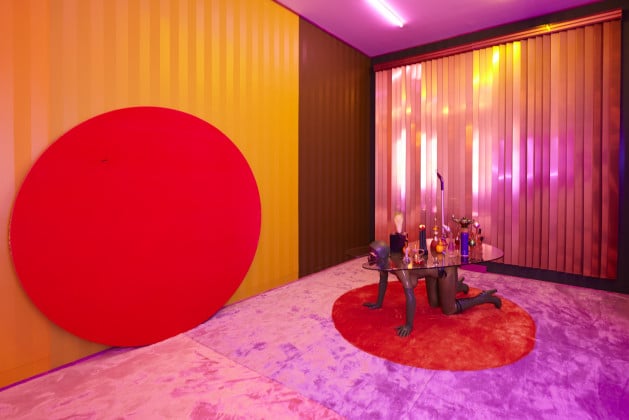
Photo: John Bernardo. Courtesy of Luxembourg & Dayan, New York.
In 1869, the French-Uruguayan poet Isidore-Lucien Ducasse, alias the Comte de Lautremont, penned the following ringer to describe a handsome boy: He was as beautiful, he effused, “as the chance meeting on a dissecting-table of a sewing-machine and an umbrella.”
Andre Breton, who knew great poetry when he saw it, borrowed the line as the perfect metaphor for Surrealist dislocation. Until now, few contemporary artistic encounters have tempted this critic to recall anything like Lautremont’s legendary image. But Alex Da Corte’s exceptionally strange show at Luxembourg & Dayan’s Upper East Side digs deserves its own bizarre comparison.
Da Corte’s exquisitely detailed transformation of an elegant townhouse into a three-story ghost motel is The Shining meets Pee Wee’s Playhouse—if this twisted fantasy were available in a 1970s-style stag theater.
New Jersey-born and Philadelphia-based, Da Corte is easily the most instinctively outlandish of a new wave of young creators who confect over-the-top environments to turn normally passive art viewing into fully immersive experiences.
Installation view of Alex Da Corte’s Die Hexe (2015).
Photo: John Bernardo. Courtesy of Luxembourg & Dayan, New York.
Like Random International’s crowd-pleasing “Rain Room,” which opened to thousands at MoMA in 2013, and Loris Greaud’s recent succès de scandale at Dallas Contemporary (he paid to have his own work destroyed at the opening), Da Corte harnesses multiple elements for his complex installations. Yet Da Corte’s work—which regularly incorporates video, painting, sculpture, design, writing, music, and found objects—eschews both schlock and shock for candy colored plunges into the uncanny.
To quote Pauline Kael on David Lynch, Da Corte is at once a thoughtful and popular surrealist. Like Lynch, he carefully composes his walk-in mind trips like “a Frank Capra of dream logic.”
Da Corte’s current uptown installation is ghoulishly titled Die Hexe in German, or “the Witch” in English. Not coincidentally, it substantially mirrors the structure of Lynch’s masterpiece Blue Velvet. Instead of an ear found on a recently clipped lawn, the entry point to Da Corte’s unsettling narrative is an actual Robert Gober drain tucked behind a peephole inside the townhouse’s ground-floor foyer (Gober was known for installing hand-made sink drains into surprising locations like walls and tables).
Starting from there, Da Corte takes his audience down an imaginary drainpipe through an additional four rooms and several hallways festooned with handmade materials and weird flourishes. Like Lynch’s film, Da Corte’s trip concludes with matching hallucinatory symmetry. Rather than close conventionally, it ends in a mint-green “cadaver room” with a second Gober drain embedded into the bottom of an autopsy tray filled with antiseptic-smelling Listerine.
A synesthetic work the artist says he made from recollections of his grandmother’s house and in memory of her failing mental health (an ex-dollhouse maker, she is slowly losing her mind to Alzheimer’s), “Die Hexe” is a kind of bottomless well of rhyming elements, motifs, quotes and references.
A wood-paneled pantry, for instance, stocks the sort of spices his Portuguese granddad once traded in, as well as a bottle of junkie piss rescued from the street; a wooden stool with extra legs matches photos of the object Kurt Cobain used to wedge the door shut before shooting himself; the shiny vinyl tile in the hallway connecting two rooms invokes the cheap wall treatments of the bodegas that dot the artist’s Philly neighborhood.
Elsewhere, a mural reproduction of a section of Nicolas Poussin’s Midas and Bacchus (1629-30) mimics the wallpaper in the 1972 Fassbinder film The Bitter Tears of Petra von Kant. As Da Corte told writer William Pym—who wrote an excellent catalog essay for the show—in the Fassbinder movie “no one ever leaves the apartment.”
Installation view of Alex Da Corte’s Die Hexe (2015).
Photo: John Bernardo. Courtesy of Luxembourg & Dayan, New York.
Also marshaled into service in Da Corte’s fulsome installation are works by three other artists with whom the artist feels a special affinity.
The first of these is a Mike Kelley stuffed animal-and-afghan sculpture located near a motorized Pennsylvania Dutch rocking chair. The second is a Bjarne Melgaard coffee table that has as its base a female mannequin done up in bondage gear. The third is a Haim Steinbach shelf work—Steinbach created what he called “framing devices,” or shelves, on which he displayed various kinds of objects, both found and hand-made. This one features a carved owl and a lumpy wooden whale—its display format having metastasized into identical shelves inside the artist’s pantry.
Da Corte’s use of these three works, together with the Gober drains, has little to do with their aura as art or as uniquely expensive items. Instead, he treats them like a special category of found objects. Things designed to carry uniquely powerful resonances, these and other objects inside Die Hexe don’t so much present themselves as contemporary visual icons, as enact active homages in the style of Robert Rauschenberg’s Erased de Kooning.
This is Alex Da Corte’s largest installation to date, and something of a preview of his upcoming solo at Mass MOCA in 2016. Don’t miss it.